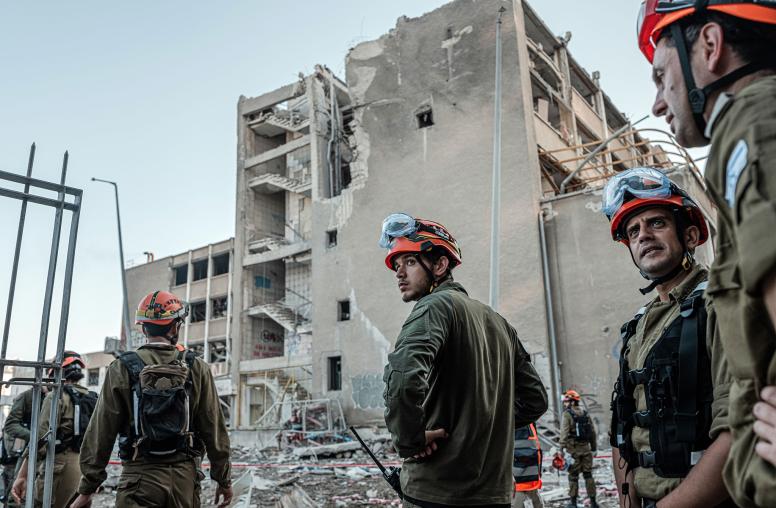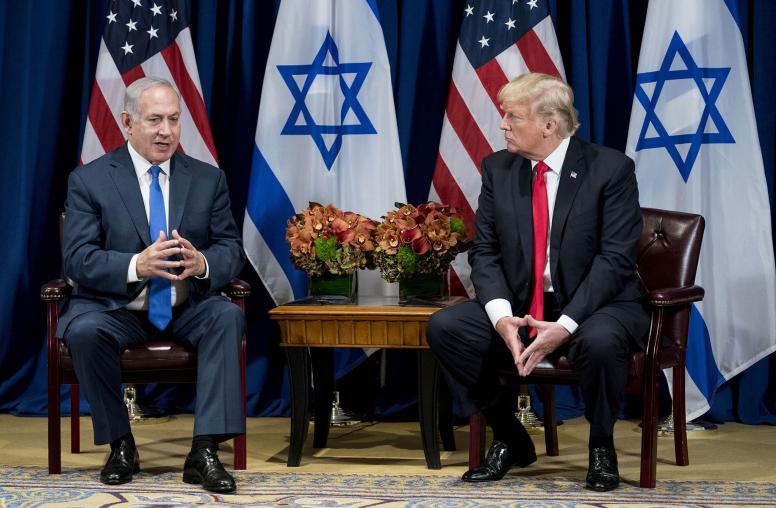The Negev Summit Furthers Arab-Israeli Normalization
The ‘homegrown’ talks signal growing regional ties despite lack of progress on two-state solution.
Earlier this week, the top diplomats from Egypt, Morocco, Bahrain, the UAE and the United States arrived in Israel at the invitation of Israeli Foreign Minister Yair Lapid for what was named the Negev Summit. Building on the normalization breakthrough started by the 2020 Abraham Accords, the summit marked a significant diplomatic shift for the region — especially as concerns mount over the fallout from Russia’s invasion of Ukraine. USIP’s Lucy Kurtzer-Ellenbogen and Ambassador Hesham Youssef look at what happened at the summit, how the topics of Iran and Russia were addressed, and what this means for the Israeli-Palestinian peace process going forward.

The summit offered a chance to further normalize ties between Israel and the Arab state signatories of the Abraham Accords. What progress was made — both tangible and symbolic — and what does it tells us about what’s next for Israel’s diplomatic place in the region?
Kurtzer-Ellenbogen: There was a hefty dose of symbolism to the Negev Summit from the outset, beginning with its location. With four Arab foreign ministers convening at their Israeli counterpart’s invitation in Kibbutz Sde Boker — the final home of Israel’s founding prime minister and first signatory of the country’s declaration of independence — Israel’s acceptance in the region was signaled with a poetic flourish.
Moreover, with Egyptian Foreign Minister Sameh Shoukry joining signatories of the historic Abraham Accords, Egypt’s pioneering — and at the time regionally controversial — step of peacemaking with Israel in 1979 appeared vindicated. This precedent was punctuated in remarks by UAE Foreign Minister Sheikh Abdullah bin Zayed Al Nahyan.
Perhaps the most tangible outcome of the summit was the announcement that it was now to become a permanent rotating forum, and press reports indicated the formation of six working groups to focus on security, energy, tourism, health, education and food and water security.
With echoes of the five working groups that grew out of the 1991 Madrid Peace Conference, there is further symbolism, albeit unintentional, that coursed through the Negev gathering. Unlike the convening of Israeli and Arab leaders in Madrid three decades earlier, which was co-hosted by the United States and Russia, this initiative was “homegrown” and home-based.
The only non-regional party present this time around was the United States — an invited guest at this otherwise regional party. And while Israeli Foreign Minister Yair Lapid was the only one to explicitly refer to “a new regional architecture to deter common enemies,” the summit underscored regional actors’ concern about the reliability of the United States to safeguard their interests. It appears they are turning instead toward self-reliance, even while making the case to the United States for ongoing support and the need to maintain the Middle East as a strategic priority.
As for Israel’s diplomatic place in the region, 55 years on from the famed “three no’s” of the Khartoum Arab League summit — “no recognition of Israel, no negotiations with Israel, no peace with Israel” — the Negev Summit and its focus on regional cooperation and coordination sent a signal that not only is Israel now accepted by key actors in the Middle East, but is itself an integrated regional player.
The Arab states in attendance have continued engaging with Israel despite little progress on a solution to the Israeli-Palestinian conflict — a historical red line for normalized relations. Where does this summit leave the future of Israeli-Palestinian talks and a two-state solution?
Kurtzer-Ellenbogen: Whether by coincidence or design, the Negev Summit took place 20 years to the day since the adoption of the Arab Peace Initiative (API) at the Beirut Arab League summit of 2002. That initiative, groundbreaking at the time, offered full normalization and peace with Israel upon Israel’s acceptance of a Palestinian state and the consummation of a two-state solution.
This API paradigm of a Palestinian state in exchange for normalization was greatly shattered with the announcement of the Abraham Accords in August 2020. And the glaring absence (let alone invitation) of Palestinian leaders at the Negev Summit underscored the extent to which the nascent set of newly-normalized relations are incidental to the Palestinian cause — flowering despite any lack of progress on that front.
Yet out of sight was not tantamount to out of consideration. U.S. Secretary of State Antony Blinken emphasized and rearticulated the U.S. goal of a two-state solution in his prepared remarks at the conclusion of the summit. Likewise, Morocco’s minister of foreign affairs, Nasser Bourita, and his Egyptian counterpart Sameh Shoukry emphasized its importance, with the latter putting the issue front and center.
So while the head of the current Israeli government, Prime Minister Naftali Bennett, has been clear that pursuit of two states is not on his agenda, the message out of Sde Boker was that the end-goal paradigm of two states is neither gone nor forgotten.
Notably missing from the gathering was Jordan — the second signatory of a peace agreement with Israel. Whether scheduling conflict or strategic decision, Jordan Foreign Minister Ayman Safadi was instead accompanying Jordan’s monarch, King Abdullah, to a meeting in Ramallah with Palestinian Authority President Mahmoud Abbas over concerns regarding the prospect of violence in Jerusalem as Ramadan, Easter and Passover are set to coincide.
As the country with arguably the most at stake with the perpetuation of the Israeli-Palestinian conflict, the persistence and growth of Israeli occupation, and the death of a two-state solution, one couldn’t help but read significance into the juxtaposition of the summit with King Abdullah’s meeting in Ramallah, whether intentional or not.
Jordan’s absence was not the only reminder that popular Arab sentiment is not yet fully on board with “the new normal,” and that some leaders need to tread carefully. Sudan, the fourth of the “new normalizers,” was also absent amid ongoing domestic crisis. And Saudi Arabia — despite advancing quiet cooperation and louder gestures toward Israel — has not yet joined the ranks of normalizing states. It is a sign that the Palestinian issue still carries weight in the Arab consciousness and, with it, the ability to stymie full-blown regional cooperation and diplomatic turning-away. Israeli-Palestinian talks seem far from in the offing. The takeaway from Sde Boker is that this will not hamper progress in areas of mutually beneficial cooperation with Israel, but neither will such cooperation make the issue disappear.
Youssef: This summit sends a number of important messages to both the Israeli public and the Israeli government. It puts another nail in the coffin for the ongoing false claim by some circles in Israel that the Arab countries do not accept Israel in the region.
Furthermore, it also sends a message that the claim Arab countries are no longer interested in the Israeli-Palestinian conflict is not true. It will be hard for public opinion in Israel not to register that those occupying the six podiums at the press conference of the summit are on the record as supporting the two-state solution.
The message to the Palestinians was that their cause was not forgotten. But at the same time, a few Arab countries may not be willing to wait for them and proactive and constructive action from their leadership is expected particularly on reconciliation and good governance. The fear is that the Palestinian public may already be moving beyond the two-state paradigm.
The topic of Iran and the stalled talks to revive the nuclear deal loomed large at the summit. Was there a consensus on how the attendees viewed the situation? What are regional leaders looking for when it comes to Iran?
Youssef: There is no doubt that the revival of the nuclear deal is an issue of great importance to those participating in the summit and beyond. The U.S. partners at the summit recognize that this issue has been an urgent priority for the Biden administration since it came to office, that the administration has a clear conviction that the maximum pressure policy of the previous administration has failed, and that therefore a return to a similar approach was highly unlikely unless Iran proved wholly inflexible and unreasonable in its positions.
With reports that a possible agreement is approaching, it can be assumed that the Negev Summit was an opportunity to discuss both possibilities: That an agreement is reached or that this latest effort fails as well.
It is doubtful that the summit aimed to reach consensus among the participants, as the positions of these players vary widely and focus on different concerns regarding Iran. Israel’s most immediate concerns are more focused on stopping Iran from developing nuclear weapons. Meanwhile, a number of countries in the region, particularly in the Gulf, are more concerned about the destabilizing policies of Iran in the Middle East — and in particular Iran’s support to its proxies in places such as Lebanon and Yemen, as well as its missiles program.
The Biden administration has also argued that once an agreement is back in place, it will aim to strengthen Iran’s nuclear commitments and to restrain its destabilizing policies, a tall order that was probably considered in the deliberations. However, the details of any discussions on this issue are yet to be revealed.
What role did Russia’s invasion of Ukraine — and the resulting U.S.-Russian tensions — play in the summit?
Youssef: Soon after the Russian invasion of Ukraine, and the imposition of unprecedented and wide-ranging sanctions on Russia, Russia demanded a written guarantee from Washington that these sanctions would not impact its trade with Iran if a nuclear deal is reached. This insistence threatened to derail the whole negotiating process, but Russia took a step back after a visit from Iran’s foreign minister.
Another important aspect of the Ukraine invasion is how current hostilities will impact food and energy security, particularly in Egypt and Morocco. Egypt is the largest importer of wheat in the world and imports over 70 percent of its wheat from Russia and Ukraine. Meanwhile, Morocco imports most of its energy needs and around half of its grain needs.
Of course, it will be much more devastating for Lebanon, Syria and Yemen given their already dire humanitarian situations and their disproportionate reliance on Russian and Ukrainian export markets. The World Bank warned that Russia’s war on Ukraine will probably have a destabilizing impact on the Middle East and Africa due to rising prices of oil, wheat, sunflower oil and other staples.
The invasion of Ukraine has also forced the United States to realize that although it’s not dependent on energy from the Arab world itself, U.S. influence was needed to try and persuade crucial energy players in the region to increase the flow of oil and gas to address Europe’s energy needs and stabilize the global energy market — which was especially crucial at a time of high inflation rates that are detrimental in what is hoped to be the post-COVID era.
However, the more important impact on the summit in this regard has to do with the perception that the United States is withdrawing from the region and the pursuant vacuum this would entail. In the context of the great power competition, both Russia and China would be eager to take advantage of this withdrawal. Russia focusing more on the political and security side, building on its influence in Syria and Libya, while China would be focusing more on the trade and investment side by building on the involvement of many countries in the region in its Belt and Road Initiative.



